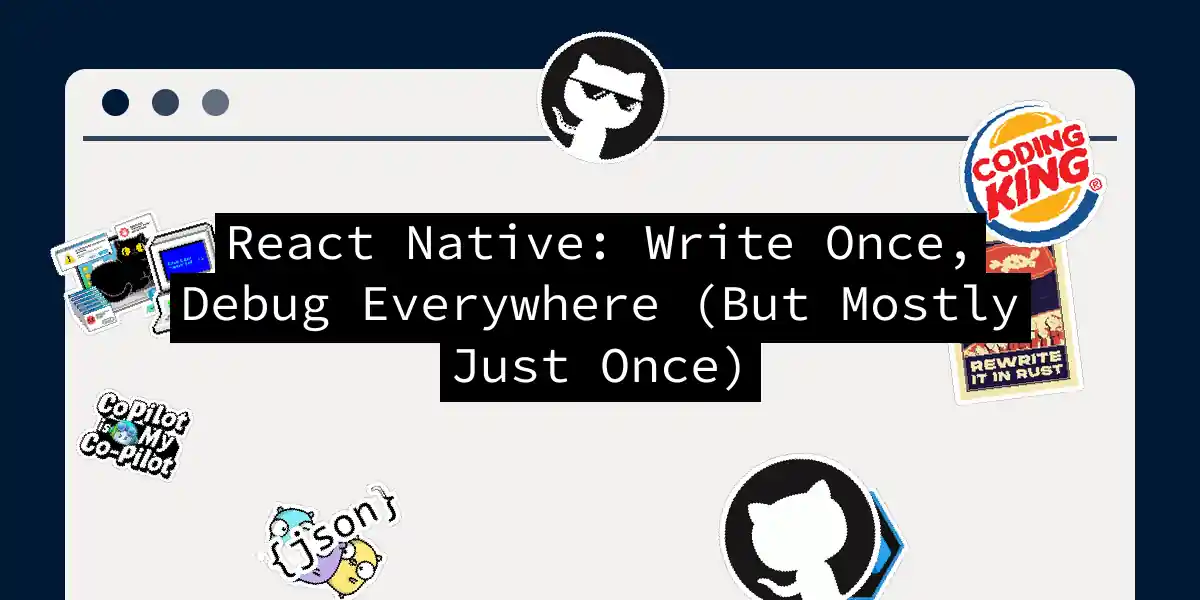Picture this: you’re at a coffee shop, trying to build both an iOS and Android app simultaneously. Your MacBook overheats from Xcode, your Android emulator eats RAM like Cookie Monster devours snacks, and your sanity slowly evaporates. Enter React Native - the JavaScript framework that’s like a Swiss Army knife for mobile development, if Swiss Army knives came with hot reloading and existential dread about flexbox alignment.
Chapter 1: Setting Up Your Digital Playground
Before we start cooking with gas, let’s set up our kitchen: Step 1: Install the essentials
# Best served with a side of coffee
npm install -g react-native-cli
Step 2: Create your project
react-native init CrossPlatformWizardry
cd CrossPlatformWizardry
Step 3: Start the Metro bundler (it’s not a subway sandwich)
npx react-native start
Now open another terminal and launch your platform of choice:
# For iOS (requires macOS)
npx react-native run-ios
# For Android (requires 8GB of patience)
npx react-native run-android
Chapter 2: The Platform Tango
Let’s create a button that knows its platform:
// PlatformButton.js
import { Platform, TouchableOpacity, Text } from 'react-native';
const PlatformButton = ({ title }) => (
<TouchableOpacity
style={{
backgroundColor: Platform.OS === 'ios' ? '#007AFF' : '#34C759',
padding: Platform.select({ ios: 12, android: 16 })
}}
>
<Text style={{ color: 'white' }}>{title}</Text>
</TouchableOpacity>
);
Behold! A button that automatically:
- Wears iOS blue on iPhones
- Rocks Android green on Pixels
- Adjusts padding like a fussy interior designer
Chapter 3: Navigation Shenanigans
Let’s add navigation using React Navigation:
npm install @react-navigation/native @react-navigation/stack
Then create our navigation structure:
// NavigationSetup.js
import { createStackNavigator } from '@react-navigation/stack';
const Stack = createStackNavigator();
const AppNavigator = () => (
<Stack.Navigator>
<Stack.Screen
name="Home"
component={HomeScreen}
options={{ title: 'Welcome to the Cross-Platform Circus' }}
/>
<Stack.Screen
name="Details"
component={DetailsScreen}
options={{ headerShown: false }}
/>
</Stack.Navigator>
);
Pro tip: Navigation is like dating - it’s all about smooth transitions and not losing your stack.
Chapter 4: The Data Dance
Let’s implement platform-specific data storage:
// StorageService.js
import { Platform } from 'react-native';
import AsyncStorage from '@react-native-async-storage/async-storage'; // iOS
import SQLite from 'react-native-sqlite-storage'; // Android
const getStorage = async () => {
if (Platform.OS === 'android') {
return SQLite.openDatabase({ name: 'app.db' });
}
return AsyncStorage;
};
const saveData = async (key, value) => {
const storage = await getStorage();
// Implementation differs between platforms...
};
This is where React Native shines - write once, abstract platform details, and avoid maintaining two separate codebases like they’re feuding siblings.
Chapter 5: Debugging War Stories
When things go sideways (and they will), try these lifesavers:
- The Shake of Truth (Cmd+D/Ctrl+M)
Your phone isn’t possessed - that’s just the developer menu - Flipper
Because every app deserves its own submarine dashboard - Platform-Specific Breakpoints
if (__DEV__ && Platform.OS === 'ios') {
console.log('Debugging on iOS? Time for a coffee refill!');
}
Remember: A crashed app is just the universe’s way of saying “Take a walk”
Chapter 6: When Platforms Collide
Sometimes you need to go full native. Here’s how to make platform-specific files:
src/
├── components/
│ ├── FancyComponent.android.js
│ └── FancyComponent.ios.js
React Native automatically picks the right file like a code-sorting psychic. Use this for:
- Platform-specific animations
- Native SDK integrations
- When iOS wants rounded corners but Android prefers sharp edges
Epilogue: The Cross-Platform Crusade Continues
After 15 cups of coffee and 3 existential crises, you’ve now got:
- A single codebase running on multiple platforms
- Platform-specific optimizations
- Navigation that doesn’t make users seasick
- The ability to detect iOS/Android without user-agent sniffing Remember, React Native isn’t about perfection - it’s about shipping faster than a startup’s runway burns through cash. Now go forth and make something that crashes on all platforms equally! (Just kidding. Mostly.) Final pro tip: When someone says “But what about Flutter?”, just smile and whisper…“JavaScript ecosystem” while slowly backing away.
